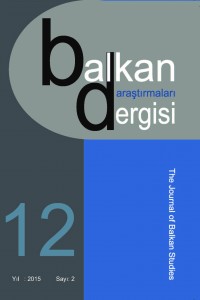Abstract
Ergenlik dönemi, her yönden geçici
bir kararsızlık dönemidir. Bu kararsızlığın doğmasına yol açan faktörlerin,
kişinin bedeni ve ruhi gelişimiyle doğrudan ilgili olduğunu tesbit etmek
mümkündür. Din ile ilgili şüphe, kararsızlık ve çatışmalar insan hayatında en
çok bu dönemde kendisini gösterirler. Geleneksel dini kalıpları tenkit ve değerlendirmeye
tabi tutarak şahsi bir din anlayışına ulaşma, genel olarak bu bunalımlı safhayı
izler. Din
psikolojisi üzerine olan bu araştırma, sosyo-psikolojik metot ve tekniklerden
faydalanılarak hazırlanmış olup Makedonya'nın Kalkandelen şehrinde yaşayan
Aranvut gençlerinin dini şüphelerinin kaynakları ve etkileri üzerinedir. Bu
bağlamda makale, onları dini şüpheye götüren faktörler, dini şüphelerin
kapsamı, dini şüpheye sebep olan konular, konuların ardındaki nedenler ve dini
şüphelere karşi tercih edilen çözüm yolları ile elde edilen sonuçlar gibi
boyutları içermektedir.
References
- Kaynakça:
- ALBAYRAK, Ahmet, Gençlerde Dua Psikolojisi, Düşünce Kitapevi Yayınları, İstanbul, 2013.
- BAHADIR, Abdülkerim, Ergenlik Döneminde Dini Şüphe Ve Tereddütler, Yayınlanmamış Yüksek Lisans Tezi, Uludağ Üniversitesi Sosyal Bilimler Enstitüsü, Bursa, 1994.
- BAHADIR, Abdülkerim, "Ergenlik Döneminde Dini Şüphe ve Tereddütler", ed. Hayati Hökelekli, Gençlik, Din Ve Değerler Psikolojisi, 2. b., Dem Yay., İstanbul, 2006.
- BİLGİN, Beyza - SELÇUK, Mualla, Din Öğretimi, Gün Yayıncılık, Ankara, 1991.
- ÇALIŞKAN, Hasan, Ailede Çocuk Terbiyesi, Çelik Yayınları, İstanbul, 2011.
- DODURGALI, Abdurahman Ailede Din Eğitimi, Timaş Yayınları, İstanbul, 2010.
- HÖKELEKLİ, Hayati, "Ergenlik Döneminde Dini Şüpheler", Din Öğretim Dergisi, 1988, Ocak-Şubat, S. 14.
- HÖKELEKLİ, Hayati, Çocuk, Genç, Aile Psikolojisi Ve Din, Timaş Yay., İstanbul, 2011.
- HÖKELEKLİ, Hayati, İslam Psikoloji Yazıları, Dem Yayınları, İstanbul, 2009.
- HÖKELEKLİ, Hayati, Ölüm, Ölüm Ötesi Psikolojisi ve Din, Dem Yayınları, İstanbul, 2008.
- JERSİLD, Arthur T., Gençlik Psikolojisi, çev. Özgür, İbrahim, N. 3. b.,Takıloğlu Matb., İstanbul, 1978.
- OSMANI, Midjit, Kalkandelen'de Yaşayan Gençlerde Dini Şüphelerin Kaynakları Ve Etkileri-(1), Balkan Araştırmaları Dergisi, C.5, S.1., Yıl. 2014, Bursa, 2015.
- ÖZBAYDAR, Belma, Din ve Tanrı İnancının Gelişmesi Üzerine Bir Araş-tırma, Baha Matb., İstanbul, 1970.
- ÖCAL, Mustafa, "Kader ve Kaza İnancının Öğretimi", Uludağ Üniversi-tesi İlahiyat Fakülte Dergisi, C.12, S.2, Bursa, 2003.
- PAUL E. Johnson, Psychology of Religion, Abingdon Press, New York, 1959.
- STARBUCK Edwin D., The Psychology of Religion, The Wallter Scott Publishing, 3. b.,1911.
- ŞAHİN, Adem, Ergenlerde Dindarlık ve Benlik, Adal Ofset Yay., Kon-ya, 2007.
- ŞENTÜRK, Habil, Din Psikolojisine Giriş, İz Yayıncılık, İstanbul, 2010.
Abstract
Adolescence is a period of ambiguity and
instability. The factors for the emergence of this ambiguity can be attributed
to the spiritual and psychological development in this phase of life. All
obscurities and conflicts in human life as well as doubts regarding religion
appear in this period. Analyzing the traditional religion forms, including all
critical aspects, contributes to the development of a personal sense of
religion, a kind of religion identity, in the youth time exactly in adolescence
period. The purpose of this article is to explore the sources and impacts of
religious doubts to Albanian adolescents living in Tetovo/Macedonia, based on
the socio-psychological methods of religious psychology. This article analyses
the root of the cause, it elaborates factors that lead to these religious
doubts, the topics behind them and the opportunities to avoid or eliminate them
also including the impact of choosing one of these opportunities.
Keywords
Macedonia Tetova Youths Religion Religious doubt Religious evolution Effect Impact Psycho-Social changes
References
- Kaynakça:
- ALBAYRAK, Ahmet, Gençlerde Dua Psikolojisi, Düşünce Kitapevi Yayınları, İstanbul, 2013.
- BAHADIR, Abdülkerim, Ergenlik Döneminde Dini Şüphe Ve Tereddütler, Yayınlanmamış Yüksek Lisans Tezi, Uludağ Üniversitesi Sosyal Bilimler Enstitüsü, Bursa, 1994.
- BAHADIR, Abdülkerim, "Ergenlik Döneminde Dini Şüphe ve Tereddütler", ed. Hayati Hökelekli, Gençlik, Din Ve Değerler Psikolojisi, 2. b., Dem Yay., İstanbul, 2006.
- BİLGİN, Beyza - SELÇUK, Mualla, Din Öğretimi, Gün Yayıncılık, Ankara, 1991.
- ÇALIŞKAN, Hasan, Ailede Çocuk Terbiyesi, Çelik Yayınları, İstanbul, 2011.
- DODURGALI, Abdurahman Ailede Din Eğitimi, Timaş Yayınları, İstanbul, 2010.
- HÖKELEKLİ, Hayati, "Ergenlik Döneminde Dini Şüpheler", Din Öğretim Dergisi, 1988, Ocak-Şubat, S. 14.
- HÖKELEKLİ, Hayati, Çocuk, Genç, Aile Psikolojisi Ve Din, Timaş Yay., İstanbul, 2011.
- HÖKELEKLİ, Hayati, İslam Psikoloji Yazıları, Dem Yayınları, İstanbul, 2009.
- HÖKELEKLİ, Hayati, Ölüm, Ölüm Ötesi Psikolojisi ve Din, Dem Yayınları, İstanbul, 2008.
- JERSİLD, Arthur T., Gençlik Psikolojisi, çev. Özgür, İbrahim, N. 3. b.,Takıloğlu Matb., İstanbul, 1978.
- OSMANI, Midjit, Kalkandelen'de Yaşayan Gençlerde Dini Şüphelerin Kaynakları Ve Etkileri-(1), Balkan Araştırmaları Dergisi, C.5, S.1., Yıl. 2014, Bursa, 2015.
- ÖZBAYDAR, Belma, Din ve Tanrı İnancının Gelişmesi Üzerine Bir Araş-tırma, Baha Matb., İstanbul, 1970.
- ÖCAL, Mustafa, "Kader ve Kaza İnancının Öğretimi", Uludağ Üniversi-tesi İlahiyat Fakülte Dergisi, C.12, S.2, Bursa, 2003.
- PAUL E. Johnson, Psychology of Religion, Abingdon Press, New York, 1959.
- STARBUCK Edwin D., The Psychology of Religion, The Wallter Scott Publishing, 3. b.,1911.
- ŞAHİN, Adem, Ergenlerde Dindarlık ve Benlik, Adal Ofset Yay., Kon-ya, 2007.
- ŞENTÜRK, Habil, Din Psikolojisine Giriş, İz Yayıncılık, İstanbul, 2010.
Details
| Journal Section | Articles |
|---|---|
| Authors | |
| Publication Date | December 30, 2015 |
| Published in Issue | Year 2015 Volume: 6 Issue: 2 |


